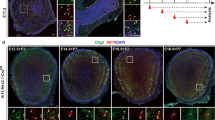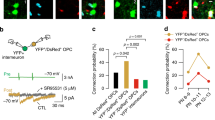Abstract
The developmental origin of oligodendrocyte progenitors (OLPs) in the forebrain has been controversial. We now show, by Cre-lox fate mapping in transgenic mice, that the first OLPs originate in the medial ganglionic eminence (MGE) and anterior entopeduncular area (AEP) in the ventral forebrain. From there, they populate the entire embryonic telencephalon including the cerebral cortex before being joined by a second wave of OLPs from the lateral and/or caudal ganglionic eminences (LGE and CGE). Finally, a third wave arises within the postnatal cortex. When any one population is destroyed at source by the targeted expression of diphtheria toxin, the remaining cells take over and the mice survive and behave normally, with a normal complement of oligodendrocytes and myelin. Thus, functionally redundant populations of OLPs compete for space in the developing brain. Notably, the embryonic MGE- and AEP-derived population is eliminated during postnatal life, raising questions about the nature and purpose of the competition.
This is a preview of subscription content, access via your institution
Access options
Subscribe to this journal
Receive 12 print issues and online access
$209.00 per year
only $17.42 per issue
Buy this article
- Purchase on Springer Link
- Instant access to full article PDF
Prices may be subject to local taxes which are calculated during checkout





Similar content being viewed by others
References
Sun, T., Pringle, N.P., Hardy, A.P., Richardson, W.D. & Smith, H.K. Pax6 influences the time and site of origin of glial precursors in the ventral neural tube. Mol. Cell. Neurosci. 12, 228–239 (1998).
Lu, Q.R. et al. Common developmental requirement for Olig function indicates a motor neuron/oligodendrocyte lineage connection. Cell 109, 75–86 (2002).
Takebayashi, H. et al. The basic helix-loop-helix factor Olig2 is essential for the development of motoneuron and oligodendrocyte lineages. Curr. Biol. 12, 1157–1163 (2002).
Zhou, Q. & Anderson, D.J. The bHLH transcription factors OLIG2 and OLIG1 couple neuronal and glial subtype specification. Cell 109, 61–73 (2002).
Cai, J. et al. Generation of oligodendrocyte precursor cells from mouse dorsal spinal cord independent of Nkx6 regulation and Shh signaling. Neuron 45, 41–53 (2005).
Fogarty, M., Richardson, W.D. & Kessaris, N. A subset of oligodendrocytes generated from radial glia in the dorsal spinal cord. Development 132, 1951–1959 (2005).
Vallstedt, A., Klos, J.M. & Ericson, J. Multiple dorsoventral origins of oligodendrocyte generation in the spinal cord and hindbrain. Neuron 45, 55–67 (2005).
Chandran, S. et al. FGF-dependent generation of oligodendrocytes by a hedgehog-independent pathway. Development 130, 6599–6609 (2004).
Kessaris, N., Jamen, F., Rubin, L. & Richardson, W.D. Cooperation between sonic hedgehog and fibroblast growth factor/MAPK signalling pathways in neocortical precursors. Development 131, 1289–1298 (2004).
Spassky, N. et al. Sonic hedgehog-dependent emergence of oligodendrocytes in the telencephalon: evidence for a source of oligodendrocytes in the olfactory bulb that is independent of PDGFR alpha signaling. Development 128, 4993–5004 (2001).
Tekki-Kessaris, N. et al. Hedgehog-dependent oligodendrocyte lineage specification in the telencephalon. Development 128, 2545–2554 (2001).
Fuccillo, M., Rallu, M., McMahon, A.P. & Fishell, G. Temporal requirement for hedgehog signaling in ventral telencephalic patterning. Development 131, 5031–5040 (2004).
Pringle, N.P. & Richardson, W.D. A singularity of PDGF alpha-receptor expression in the dorsoventral axis of the neural tube may define the origin of the oligodendrocyte lineage. Development 117, 525–533 (1993).
He, W., Ingraham, C., Rising, L., Goderie, S. & Temple, S. Multipotent stem cells from the mouse basal forebrain contribute GABAergic neurons and oligodendrocytes to the cerebral cortex during embryogenesis. J. Neurosci. 21, 8854–8862 (2001).
Marshall, C.A. & Goldman, J.E. Subpallial Dlx2-expressing cells give rise to astrocytes and oligodendrocytes in the cerebral cortex and white matter. J. Neurosci. 22, 9821–9830 (2002).
Perez Villegas, E.M. et al. Early specification of oligodendrocytes in the chick embryonic brain. Dev. Biol. 216, 98–113 (1999).
Olivier, C. et al. Monofocal origin of telencephalic oligodendrocytes in the chick embryo: the entopeduncular area. Development 128, 1757–1769 (2000).
Gorski, J.A. et al. Cortical excitatory neurons and glia, but not GABAergic neurons, are produced in the Emx1-expressing lineage. J. Neurosci. 22, 6309–6314 (2002).
Levison, S.W. & Goldman, J.E. Both oligodendrocytes and astrocytes develop from progenitors in the subventricular zone of postnatal rat forebrain. Neuron 10, 201–212 (1993).
Luskin, M.B. & McDermott, K. Divergent lineages for oligodendrocytes and astrocytes originating in the neonatal forebrain subventricular zone. Glia 11, 211–226 (1994).
Spassky, N. et al. Multiple restricted origin of oligodendrocytes. J. Neurosci. 18, 8331–8343 (1998).
Nery, S., Wichterle, H. & Fishell, G. Sonic hedgehog contributes to oligodendrocyte specification in the mammalian forebrain. Development 128, 527–540 (2001).
Wichterle, H., Turnbull, D.H., Nery, S., Fishell, G. & Alvarez-Buylla, A. In utero fate mapping reveals distinct migratory pathways and fates of neurons born in the mammalian basal forebrain. Development 128, 3759–3771 (2001).
Ivanova, A. et al. Evidence for a second wave of oligodendrogenesis in the postnatal cerebral cortex of the mouse. J. Neurosci. Res. 73, 581–592 (2003).
Palmiter, R.D. et al. Cell lineage ablation in transgenic mice by cell-specific expression of a toxin gene. Cell 50, 435–443 (1987).
Corbin, J.G., Nery, S. & Fishell, G. Telencephalic cells take a tangent: non-radial migration in the mammalian forebrain. Nat. Neurosci. 4, 1177–1182 (2001).
Parnavelas, J.G. The origin and migration of cortical neurones: new vistas. Trends Neurosci. 23, 126–131 (2000).
Marin, O. & Rubenstein, J.L. A long, remarkable journey: tangential migration in the telencephalon. Nat. Rev. Neurosci. 2, 780–790 (2001).
Hart, I.K., Richardson, W.D., Heldin, C.-H., Westermark, B. & Raff, M.C. PDGF receptors on cells of the oligodendrocyte-type-2 astrocyte (O-2A) cell lineage. Development 105, 595–603 (1989).
Hall, A., Giese, N.A. & Richardson, W.D. Spinal cord oligodendrocytes develop from ventrally derived progenitor cells that express PDGF alpha-receptors. Development 122, 4085–4094 (1996).
Stolt, C.C. et al. Terminal differentiation of myelin-forming oligodendrocytes depends on the transcription factor Sox10. Genes Dev. 16, 165–170 (2002).
Breitman, M.L. et al. Genetic ablation: targeted expression of a toxin gene causes microphthalmia in transgenic mice. Science 238, 1563–1565 (1987).
Altman, J. Proliferation and migration of undifferentiated precursor cells in the rat during postnatal gliogenesis. Exp. Neurol. 16, 263–278 (1966).
Roelink, H. et al. Floor plate and motor neuron induction by vhh-1, a vertebrate homolog of hedgehog expressed by the notochord. Cell 76, 761–775 (1994).
Echelard, Y. et al. Sonic hedgehog, a member of a family of putative signaling molecules, is implicated in the regulation of CNS polarity. Cell 75, 1417–1430 (1993).
Ericson, J. et al. Sonic hedgehog induces the differentiation of ventral forebrain neurons: a common signal for ventral patterning within the neural tube. Cell 81, 747–756 (1995).
Poncet, C. et al. Induction of oligodendrocyte precursors in the trunk neural tube by ventralizing signals: effects of notochord and floor plate grafts, and of sonic hedgehog. Mech. Dev. 60, 13–32 (1996).
Pringle, N.P. et al. Determination of neuroepithelial cell fate: induction of the oligodendrocyte lineage by ventral midline cells and Sonic hedgehog. Dev. Biol. 177, 30–42 (1996).
Ericson, J. et al. Pax6 controls progenitor cell identity and neuronal fate in response to graded Shh signaling. Cell 90, 169–180 (1997).
Orentas, D.M., Hayes, J.E., Dyer, K.L. & Miller, R.H. Sonic hedgehog signaling is required during the appearance of spinal cord oligodendrocyte precursors. Development 126, 2419–2429 (1999).
Bjartmar, C., Hildebrand, C. & Loinder, K. Morphological heterogeneity of rat oligodendrocytes: electron microscopic studies on serial sections. Glia 11, 235–244 (1994).
Butt, A.M., Ibrahim, M., Ruge, F.M. & Berry, M. Biochemical subtypes of oligodendrocyte in the anterior medullary velum of the rat as revealed by the monoclonal antibody Rip. Glia 14, 185–197 (1995).
Butt, A.M., Ibrahim, M. & Berry, M. The relationship between developing oligodendrocyte units and maturing axons during myelinogenesis in the anterior medullary velum of neonatal rats. J. Neurocytol. 26, 327–338 (1997).
Calver, A.R. et al. Oligodendrocyte population dynamics and the role of PDGF in vivo. Neuron 20, 869–882 (1998).
van Heyningen, P., Calver, A.R. & Richardson, W.D. Control of progenitor cell number by mitogen supply and demand. Curr. Biol. 11, 232–241 (2001).
Shimshek, D.R. et al. Codon-improved Cre recombinase (iCre) expression in the mouse. Genesis 32, 19–26 (2002).
Maxwell, F., Maxwell, I.H. & Glode, L.M. Cloning, sequence determination, and expression in transfected cells of the coding sequence for the tox 176 attenuated diphtheria toxin A chain. Mol. Cell. Biol. 7, 1576–1579 (1987).
Lee, E.C. et al. A highly efficient Escherichia coli-based chromosome engineering system adapted for recombinogenic targeting and subcloning of BAC DNA. Genomics 73, 56–75 (2001).
Mao, X., Fujiwara, Y., Chapdelaine, A., Yang, H. & Orkin, S.H. Activation of EGFP expression by Cre-mediated excision in a new ROSA26 reporter mouse strain. Blood 97, 324–326 (2001).
Soriano, P. Generalized lacZ expression with the ROSA26 Cre reporter strain. Nat. Genet. 21, 70–71 (1999).
Acknowledgements
We thank our colleagues at the Wolfson Institute for Biomedical Research and elsewhere for discussion, technical help and advice—especially M. Fruttiger, U. Dennehy and R. Taveira-Marques. We thank I. Maxwell for supplying the DTA plasmid. This work was funded by the UK Medical Research Council, the Wellcome Trust Functional Genomics Initiative and a Wellcome Trust Prize Studentship (M.F.).
Author information
Authors and Affiliations
Corresponding authors
Ethics declarations
Competing interests
The authors declare no competing financial interests.
Supplementary information
Supplementary Fig. 1
Cre deleter lines. (PDF 780 kb)
Rights and permissions
About this article
Cite this article
Kessaris, N., Fogarty, M., Iannarelli, P. et al. Competing waves of oligodendrocytes in the forebrain and postnatal elimination of an embryonic lineage. Nat Neurosci 9, 173–179 (2006). https://doi.org/10.1038/nn1620
Received:
Accepted:
Published:
Issue Date:
DOI: https://doi.org/10.1038/nn1620
This article is cited by
-
Expression patterns of Piezo1 in the developing mouse forebrain
Brain Structure and Function (2024)
-
Outcomes of the 2019 hydrocephalus association workshop, "Driving common pathways: extending insights from posthemorrhagic hydrocephalus"
Fluids and Barriers of the CNS (2023)
-
Direct association with the vascular basement membrane is a frequent feature of myelinating oligodendrocytes in the neocortex
Fluids and Barriers of the CNS (2023)
-
Distinct requirements for Tcf3 and Tcf12 during oligodendrocyte development in the mouse telencephalon
Neural Development (2023)
-
Myelination-independent functions of oligodendrocyte precursor cells in health and disease
Nature Neuroscience (2023)



